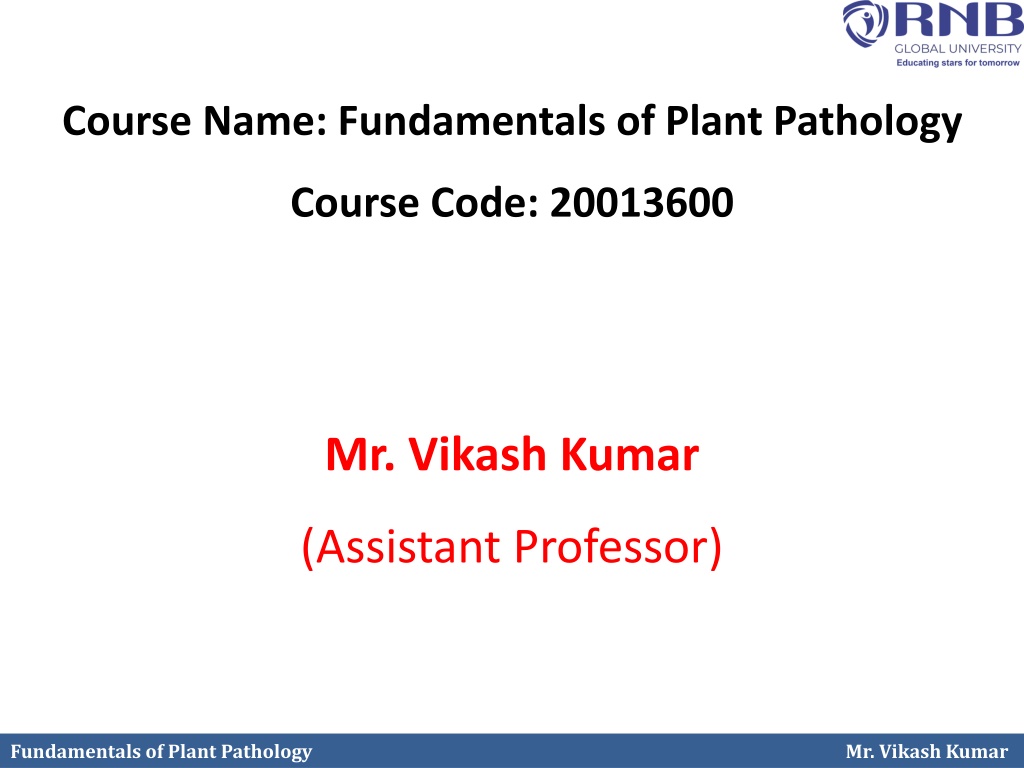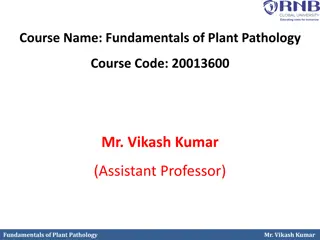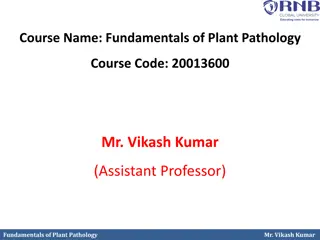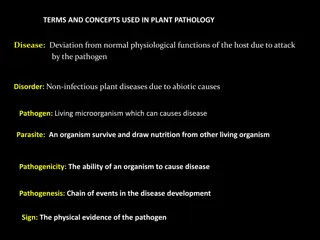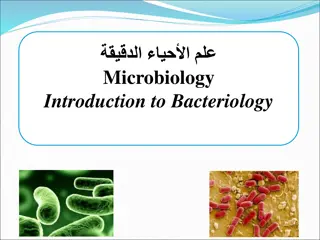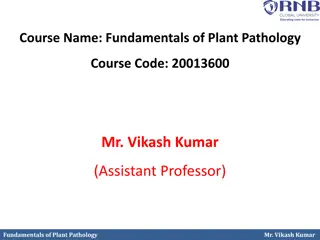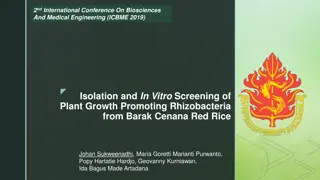Understanding Bacterial Characteristics in Plant Pathology
This course delves into the fundamentals of plant pathology, focusing on the identification, nature, and management strategies of plant diseases caused by bacteria. Topics include the morphology of phytopathogenic bacteria, their characteristics, shapes, and cell envelope structures. Gain insights into the role of capsules in bacterial survival and virulence, essential for plant disease diagnosis and management.
- Plant Pathology
- Bacterial Characteristics
- Phytopathogenic Bacteria
- Disease Management
- Bacterial Cell
Download Presentation

Please find below an Image/Link to download the presentation.
The content on the website is provided AS IS for your information and personal use only. It may not be sold, licensed, or shared on other websites without obtaining consent from the author. Download presentation by click this link. If you encounter any issues during the download, it is possible that the publisher has removed the file from their server.
E N D
Presentation Transcript
Course Name: Fundamentals of Plant Pathology Course Code: 20013600 Mr. Vikash Kumar (Assistant Professor) Fundamentals of Plant Pathology Mr. Vikash Kumar
Course Objectives 1: Name and identify different Diseases, nature of pathogens and different strategies for management of plant diseases. 2: Outline concepts, nomenclature, classification and characters of pathogens 3: Apply different principles and methods for plant disease management. 4: Take a part in identification of diseases and marketing of relevant pesticides. 5: Conclude methods to diagnose and manage a wide range of plant diseases. Fundamentals of Plant Pathology Mr. Vikash Kumar
Bacteria and mollicutes general morphological characters Fundamentals of Plant Pathology Mr. Vikash Kumar
BACTERIA Definition: Bacteria are extremely minute, rigid, essentially unicellular organisms (actinomycetes are filamentous), devoid of chlorophyll, most commonly reproduce by transverse binary fission. Important characteristics of phytopathogenic bacteria: 1. Straight to curved rods with rigid cell walls (except filamentous bacteria). Size: 0.5 to 3.5 m in length and 0.5 to 1.0 m in diameter. 2. Mostly aerobic or oxidative, except Erwinia 3. Mostly gram negative, rarely gram positive (Gr + ve genera: Bacillus, Streptomyces, Clavibacter. 4. Phytopathogenic Bacteria (PPB) can be cultured on artificial media. 5. Majority are flagellate. 6. These are passive invaders, i.e., enter plants through wounds or natural openings. 7. All are susceptible to phages. 8. All are non-spore formers except Bacillus. Fundamentals of Plant Pathology Mr. Vikash Kumar
SHAPE: They may be spherical (Coccus Cocci), or Straight rods (Bacillus Bacilli), or rods that are helically curved (Spirillum Spirilli) or pleomorphic (exhibit a variety of shapes). Fundamentals of Plant Pathology Mr. Vikash Kumar
Bacterial Cell Fundamentals of Plant Pathology Mr. Vikash Kumar
Cell Envelope - The cell envelope is made up of two to three layers: the innermost cytoplasmic membrane is cell wall, middle layer is cell wall and in some species of bacteria an outer layer is capsule slime layer. Capsule - Some species of bacteria have a third protective covering, a capsule made up of polysaccharides (complex carbohydrates). Capsules play a most important role are to keep the bacterium from drying out and to protect it from phagocytosis (engulfing) by larger microorganisms. The capsule is a major virulence factor in the major disease-causing bacteria, such as Escherichia coli and Streptococcus pneumoniae. Nonencapsulated mutants of these organisms are avirulent, i.e. they don't cause disease. Fundamentals of Plant Pathology Mr. Vikash Kumar
Cell Wall - Each bacterium is enclosed by a rigid cell wall composed of peptidoglycan, a protein-sugar (polysaccharide) molecule. The wall gives the cell its shape and surrounds the cytoplasmic membrane, protecting it from the environment. It also helps to anchor appendages like the pili and flagella, which originate in the cytoplasm membrane and protrude through the wall to the outside. Cytoplasmic Membrane - This is about 7.5 m thick and primarily composed of phospholipids (20-30%) and proteins (60-70%). Encloses the interior of the bacterium, regulating the flow of materials in and out of the cell. Fundamentals of Plant Pathology Mr. Vikash Kumar
Cytoplasm - The cytoplasm, or protoplasm, of bacterial cells is where the functions for cell growth, metabolism, and replication are carried out. It is a gel-like matrix composed of water, enzymes, nutrients, wastes, and gases and contains cell structures such as ribosomes, chromosome and plasmids. Flagella - Flagella (singular, flagellum) are hairlike structures, helps for locomotion and made up of flagellin protein. Pili - Many species of bacteria have pili (singular, pilus), small hairlike projections, made up of pillin protein, emerging from the outside cell surface. Without pili, many disease-causing bacteria lose their ability to infect because they're unable to attach to host tissue. Specialized pili are used for conjugation, during which two bacteria exchange fragments of plasmid DNA. Fundamentals of Plant Pathology Mr. Vikash Kumar
Nucleoid (Bacterial Chromosome) - The nucleoid is a region of cytoplasm where the chromosomal DNA is located. It is not a membrane bound nucleus, but simply an area of the cytoplasm where the strands of DNA are found. Plasmids - Plasmids are small, extrachromosomal circular piece of DNA carried by many strains of bacteria. Ability of self-replicating. Ribosomes - Ribosomes are microscopic "factories" found in all cells, including bacteria. Mesosomes: In many bacteria, especially Gram-positive bacteria, the cytoplasmic membrane appears to be infolded at more than one point are called mesosomes. Fundamentals of Plant Pathology Mr. Vikash Kumar
Sphaeroplast: The bacterial cells lacking cell wall and present an outer membrane and a plasma (inner) membrane are called spheroplasts. spheroplasts have two - an inner membrane and an outer membrane. Spaeroplast produced from Gram- negative bacteria Protoplast:. The bacterial cells lacking cell wall and present an only inner membrane are called protoplasts. Protoplasts produced from Gram-positive bacteria. A protoplast is that portion of a bacterial cell consisting of the cytoplasmic membrane and the cell material bound by it. Cell wall composition: The cell wall is made up of peptidoglycan and very rigid and gives the shape to the cell. Peptidoglycan is basically a polymer of N- acetyl glucosamine, N- acetyl muramic acid, L- alanine, D-alanine, D-glutamate and di amino acid. Fundamentals of Plant Pathology Mr. Vikash Kumar
Disease - Bacteria 1. Wilt of solanaceous crops (tomato) - Raltsonia (Pseudomonas) solanacearum 2. Wild fire of tobacco - P. syringae p.v. tabaci (fluorescent pseudomonads) 3. Bacterial Blight of paddy - Xanthomonas campestris p.v. oryzae 4. Citrus canker - X. axonopodis p.v. citri 5. Black arm/angular leaf spot of cotton - X. campestris p.v. malvacearum 6. Black rot of crucifers - X. campestris p.v. campestris 7. Crown gall of apple - Agrobacterium tumefaciens 8. Soft rot of vegetables - Erwinia carotovora 9. Fire blight of apple - E. amylovora 10. Tundu disease of wheat - Corynebacterium tritici 11. Common scab of potato - Streptomyces scabies Fundamentals of Plant Pathology Mr. Vikash Kumar
Mollicutes Mollicutes- molli (soft), cute (skin) Two types : (1.) Phytoplasma and (2.) Spiroplasma (1.) Phytoplasma Definition: prokaryotic, pleomorphic, resemble mycoplasma, wall less, self-replicating, pass through filters, sensitive to tetracyclines, transmission by leaf hoppers. Important characteristics of phytoplasmas: Size vary from 100 nanometers to 1 micrometer dia. Wall less, covered by trilamellar unit membrane with lipoproteins. Cells pleomorphic Aerobic to facultative anaerobes Found intracellularly in phloem vessels of plants Ribosomes of bacterial type Genome is made up of ds circular DNA , Osmotically stable Self-replicable by transverse binary fission Obligate parasites Non Flagellate, non-spore former and gram ve. Resistant to penicillin but sensitive to tetracycline & chloramphenicol Fundamentals of Plant Pathology Mr. Vikash Kumar
Symptoms in plants relatable with viral infection. Transmission by leaf hoppers and grafting Require sterols for growth Can be controlled by thermotherapy by growing plants at 37- 40 o C. Eg. Mulberry dwarf DISEASES CAUSED BY PHYTOPLASMAS AND VECTORS Disease and Vector 1. Aster yellows - (leaf hopper ) 2. Sesamum phyllody- (leaf hopper) 3. Mulberry dwarf - (leaf hopper) 4. Sandal spike - (leaf hopper) 5. Little leaf brinjal- (leaf hopper) 6. Grassy shoot- sugarcane Aphis maydis (aphid) 7. Potato witches broom - (leaf hopper) Fundamentals of Plant Pathology Mr. Vikash Kumar
(2.) Spiroplasmas (helical mollicutes) Definition: helical, wall less prokaryotes, phloem of diseased plants, helical in structure, a kind of mycoplasmas, but can be cultured. Important characteristics: Helical in liquid media Size vary from 100- 240 nm dia. Grown on culture medium in laboratory medium. Gram + ve Colonies appear like fried egg in culture medium. Multiplication by transverse binary fission No flagella. Resistant to penicillin but sensitive to tetracycline Fundamentals of Plant Pathology Mr. Vikash Kumar
Important diseases and transmission: Disease Vector - (leaf hopper) 1. Corn stunt - Dalbulus elimatus 2. Citrus stubborn - Circulifer tenellus Fundamentals of Plant Pathology Mr. Vikash Kumar
Thank You Fundamentals of Plant Pathology Mr. Vikash Kumar
